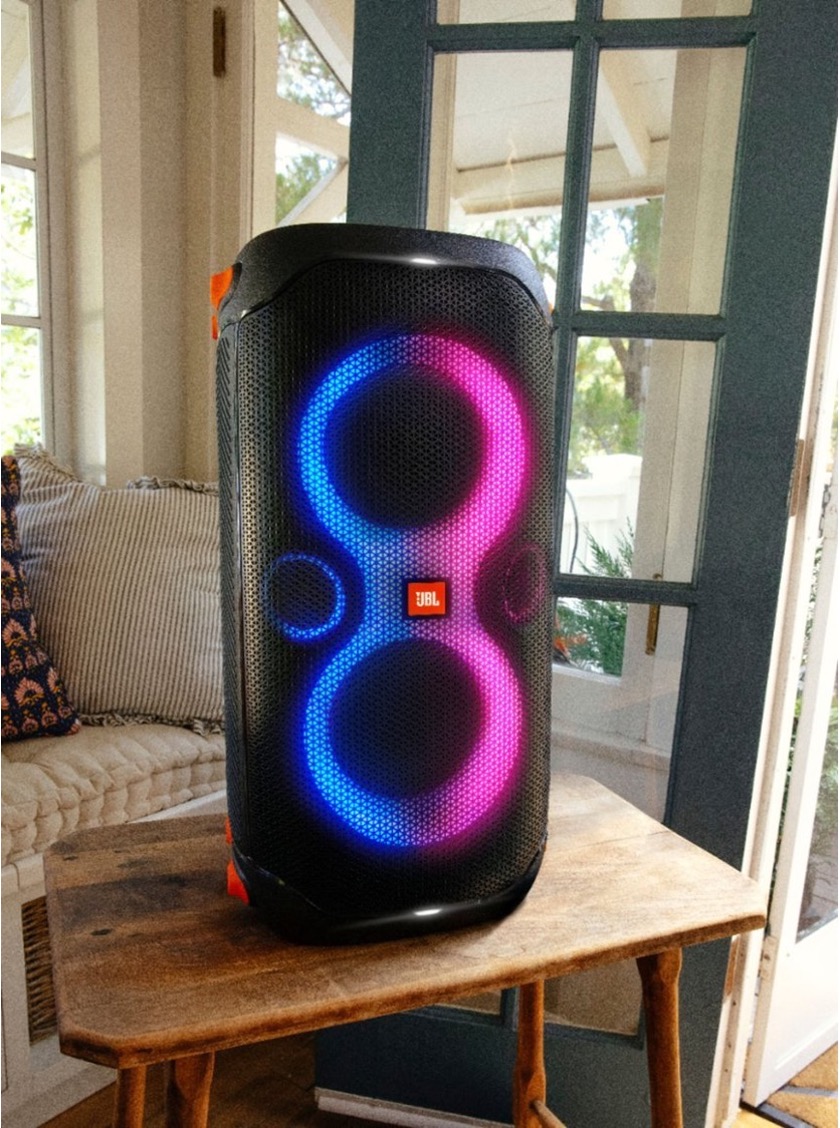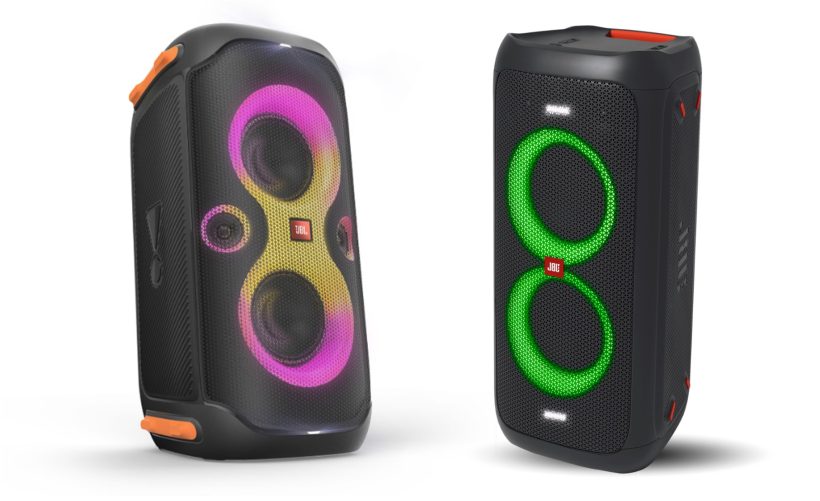The JBL PartyBox 110 delivers a slight upgrade from the JBL PartyBox 100 with a wider frequency range and more updated specs including Bluetooth 5.1 and a water-resistant IPX4 design as compared to the JBL PartyBox 100. Both speakers deliver really loud and clean sound performance, with both speakers delivering 160W RMS of output power which is more than the JBL Boombox 3’s 136W RMS. While both speakers deliver deep bass performance down to 45Hz, the PartyBox 110 can deliver better highs (up to 20kHz) and deliver clearer vocal performances.
While the JBL PartyBox 110 delivers some modest improvements over the PartyBox 100, the JBL PartyBox 100 is still the more affordable option and the main benefit that you are getting from the PartyBox 110 is essentially the IPX4 water-resistant design for outdoor use. This would be a game changer if you intend to use the speaker for outdoor parties or poolside events; otherwise the JBL PartyBox 110 delivers virtually the same sound performance as the PartyBox 100.
Read more: The 15 Loudest Bluetooth Speakers Ranked
Comparing the Specs
| Specifications | JBL PartyBox 100 | JBL PartyBox 110 |
| Output Power | 160W Peak | 160W RMS |
| Frequency Response | 45Hz – 18kHz | 45Hz – 20kHz |
| Battery Life | Up to 12 hours | Up to 12 hours |
| Battery Charge Time | 3.5-4 hours | 3.5 hours |
| Transducers | 2x 5.25″ Woofers, 2x 2.25″ Tweeter | 2 x 5.25″ woofer, 2 x 2.25″ tweeter |
| Bluetooth Version | 4.2 | 5.1 |
| Weight | 21.4 lbs | 23.9 lbs |
| Dimensions (WxDxH) | 11.3 x 21.7 x 11.4” | 11.8 x 22.4 x 11.6” |
| Waterproof Rating | No | IPX4 |
| Bluetooth Range | 10 Meters (33 feet) | 10 Meters (33 feet) |
| Signal to Noise Ratio | > 80dB | > 80dB |
| Supported Formats | MP3, WAV, WMA | MP3, WAV, WMA |
| Connectivity | Bluetooth, USB, AUX, Microphone Input | Bluetooth, USB, AUX, TWS, Microphone Input |
The key differences include the JBL PartyBox 110’s improved frequency response range especially in the higher frequency ranges. The PartyBox 110 also has a more specific waterproof rating (IPX4), making it suitable for outdoor use where it might be exposed to splashing water. The PartyBox 110 supports Bluetooth 5.1 which is a slight upgrade compared to the PartyBox 100’s Bluetooth 4.2 version. Additionally, the PartyBox 110 and PartyBox 100 speakers support True Wireless Stereo (TWS), allowing for pairing with another speaker for a stereo sound experience.
Both speakers have a substantial battery life of up to 12 hours and they are closely matched in terms of power with both delivering 160W RMS of output power.
Read more: JBL PartyBox 110 Review: Is this speaker worth getting?

Sound Performance
When we compared both the PartyBox 110 and the PartyBox 100 speakers side by side, both speakers deliver really nice bass and punchy beats especially with EDM and pop music genres. These speakers can produce good midranges and crisp highs that do not sound harsh or distorted, and you can pump up on the volume on both speakers and get very little distortion. In terms of sound signature, both the PartyBox 110 and the PartyBox 100 have relatively the same sound profile with a V-shaped sound signature emphasizing the highs and the lows.
At higher volume levels, we did find that the PartyBox 110 was capable of delivering clearer highs and vocals with smooth timbre ranges. You can hear the vocalist clearly in any EDM or rock music soundtrack and the sound does not muddy into the midrange. The PartyBox 110 sounded slightly clearer in the highs due to its wider frequency range up to 20 kHz (as compared to the PartyBox 100’s 18 kHz), and the highs come across as brighter and more well-defined than the PartyBox 100 speaker.
Both speakers have the same amount of bass impact and we did not notice anything substantially different between both speakers in terms of bass output. The bass does punch deep and has plenty of depth, but they sound much better if you turn up the volume on both speakers. Both the PartyBox 100 and the PartyBox 110 are powered by dual 5.25” woofers which deliver roughly the same amount of bass and low-end frequency ranges down to 45 Hz.

Design and Specs
The PartyBox 110 builds upon the PartyBox 100’s foundation with several enhancements. It delivers powerful sound with JBL Original Pro Sound and adjustable bass, covering a frequency range from 45Hz to 20kHz. What sets it apart is the dynamic LED light rings that sync with the music, providing an immersive audiovisual experience. This model is slightly taller and weighs about the same as the PartyBox 100 but designed to be splashproof with an IPX4 rating, making it ideal for outdoor parties. It features Bluetooth 5.1 for connectivity and provides up to 12 hours of playtime on a single charge, which is more updated than the PartyBox 100’s Bluetooth 4.2 codec.
Both models come with additional features like compatibility with the JBL PartyBox app, support for TWS (True Wireless Stereo) for pairing two speakers, and microphone connectivity. The PartyBox 110 also comes with additional inputs for mic and guitar together with an LED light show that keeps the party going.
The Verdict?
The JBL PartyBox 110 does provide several marginal improvements over its predecessor, the PartyBox 100 which makes it a more portable outdoor speaker with IPX4 water-resistance. The PartyBox 110 is slightly larger and heavier (it weighs 10.84 kg as compared to the PartyBox 100’s 9.7 kg), and has a slightly wider frequency range which extends up to 20 kHz. While both speakers support Bluetooth, 3.5mm auxiliary and have a guitar/mic input with volume control, only the PartyBox 110 supports the JBL PartyBox app which provides features such as true wireless stereo and additional customization options. Apart from this, both speakers have a similar sound profile and equally good bass response, although the PartyBox 110 is better able to articulate the highs we more detail.
If you are deciding between both speakers, we recommend the JBL PartyBox 110 as it delivers much more functionality and IPX4 water-resistance which makes it suitable for playing music in outdoor spaces or for pool parties. It also supports the JBL app which provides much more customization options, which makes it a more versatile speaker to get.

